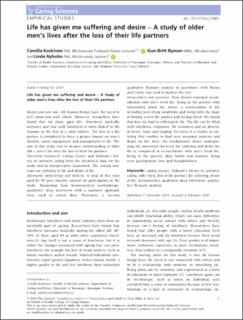| dc.contributor.author | Koskinen, Camilla Ann-Louise | |
| dc.contributor.author | Nyman, Gun-Britt | |
| dc.contributor.author | Nyholm, Linda | |
| dc.date.accessioned | 2021-02-15T09:08:07Z | |
| dc.date.available | 2021-02-15T09:08:07Z | |
| dc.date.created | 2020-02-27T10:30:45Z | |
| dc.date.issued | 2020 | |
| dc.identifier.citation | Koskinen, C., Nyman, G-B., Nyholm, L. (2020) Life has given me suffering and desire – A study of older men’s lives after the loss of their life partners. Scandinavian Journal of Caring Sciences, | en_US |
| dc.identifier.issn | 0283-9318 | |
| dc.identifier.uri | https://hdl.handle.net/11250/2727977 | |
| dc.description.abstract | Background and aim
All human beings have the need to feel connected with others. However, researchers have found that for those aged 80+, loneliness markedly increases and that such loneliness is often linked to life changes or the loss of a close relative. The loss of a life partner is considered to have a greater impact on men’s identify, social engagement and management of life. The aim of this study was to deepen understanding of older (80+) men’s life after the loss of their life partners.
Theoretical framework
Caring science and Eriksson’s theory of caritative caring form the theoretical base for the study and its interpretative framework. The central concepts are suffering of life and desire of life.
Informants, methodology and methods
A total of five men aged 81–91 gave thereby consent for participation in the study. Emanating from hermeneutical methodology, qualitative deep interviews with a narrative approach were used to collect data. Thereafter, a six‐step qualitative thematic analysis in accordance with Braun and Clarke was used to analyse the text.
Interpretation and conclusion
Four themes emerged: reconciliation with one’s lived life, living in the present with uncertainty about the future, a reorientation in life including new living conditions and living with the hope of finding a new life partner and feeling loved. We found that loss can lead to suffering in life. The life can be filled with loneliness, emptiness, life weariness and an absence of desire, hope and longing. Yet there is a vitality in suffering that enables to find new meaning contexts and desire for life. Here, the fundamental choice underpinning the movement between life suffering and desire for life is comprised of reconciliation with one’s lived life, living in the present, daily habits and routines, being seen, participation, love and thoughtfulness. | en_US |
| dc.language.iso | eng | en_US |
| dc.publisher | John Wiley & Sons Ltd. | en_US |
| dc.rights | Attribution-NonCommercial-NoDerivatives 4.0 Internasjonal | * |
| dc.rights.uri | http://creativecommons.org/licenses/by-nc-nd/4.0/deed.no | * |
| dc.subject | sorg | en_US |
| dc.subject | enkemenn | en_US |
| dc.subject | eldre | en_US |
| dc.title | Life has given me suffering and desire – A study of older men’s lives after the loss of their life partners | en_US |
| dc.type | Journal article | en_US |
| dc.type | Peer reviewed | en_US |
| dc.description.version | publishedVersion | en_US |
| dc.rights.holder | © 2020 The Authors | en_US |
| dc.subject.nsi | VDP::Medical disciplines: 700::Health sciences: 800 | en_US |
| dc.source.journal | Scandinavian Journal of Caring Sciences | en_US |
| dc.identifier.doi | 10.1111/scs.12831 | |
| dc.identifier.cristin | 1798074 | |
| dc.relation.project | Universitetet i Stavanger: Universitetet i Stavanger IN -10519 | en_US |
| cristin.ispublished | true | |
| cristin.fulltext | original | |
| cristin.qualitycode | 1 | |

